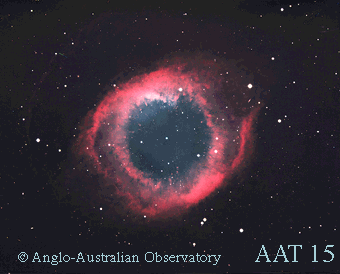Astronomy Picture of the Day
Discover the cosmos!
Each day a different image or photograph of our fascinating universe is
featured, along with a brief explanation written by a professional
astronomer.
April 17, 1996

NGC 7293: The Helix Nebula
Credit:
Anglo-Australian Telescope
photograph by David Malin
Copyright:
Anglo-Australian Telescope
Board
Explanation:
The Helix nebula (New General Catalog number 7293)
is estimated to be a mere 450 light-years from the Sun, in the
direction of the
constellation Aquarius.
At that distance it may well be the closest
planetary nebula,
offering a dramatic snapshot of a brief
final evolutionary stage in the life of a solar-type star.
In this color image the nebula glows red in the light of
nitrogen and hydrogen atoms energized by the
ultraviolet radiation
from the central star.
The main rings themselves, though faint, have an angular
size about half that of the full moon and span about 1.5 light-years.
Because it is so close, it is a prime subject for
study by astronomers. When the Hubble Space Telescope was focused
near the inner edge of the main ring, at about the 12 o'clock position
in the above image,
it resolved some of the spoke like radial structures visible into
intriguing cometary knots.
Information:
The
Scale of the Universe Debate in April 1996
Tomorrow's picture: Hyakutake, Venus, Orion, and Pond
| Archive
| Index
| Search
| Glossary
| Education
| About APOD |




Authors & editors:
Robert Nemiroff
(GMU) &
Jerry
Bonnell (USRA).
NASA Technical Rep.:
Sherri
Calvo.
Specific rights apply.
A service of:
LHEA
at
NASA/
GSFC




